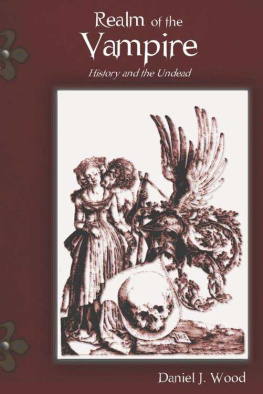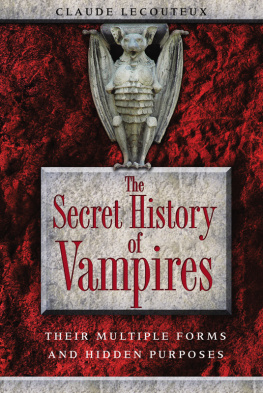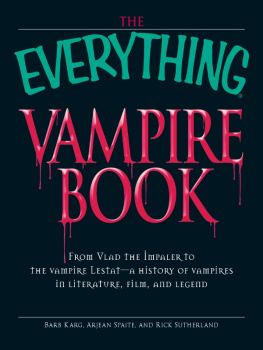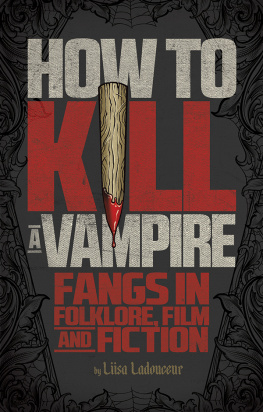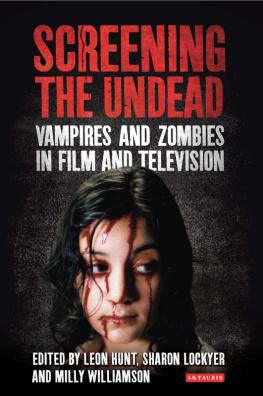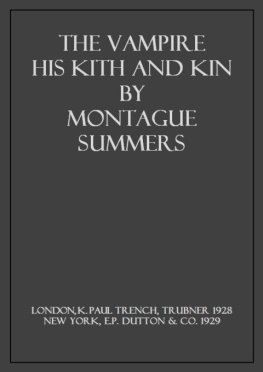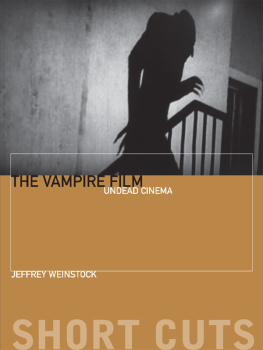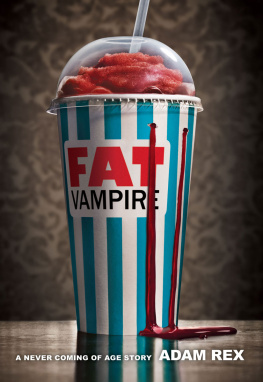Daniel J. Wood
Galde Press, Inc.
Lakeville, Minnesota, U.S.A.
Copyright 2009 by Daniel J. Wood
All rights reserved.
No part of this book may be used or reproduced in any manner whatsoever without written permission from the publishers except in the case of brief quotations embodied in critical articles and reviews.
Galde Press, Inc.
Foreword
On a cold night in autumn 1969 I read Bram Stokers Dracula while alone on my parents farm in central Minnesota. Discovering his hosts vampiric nature, Jonathan Harker froze with horror. There lay the count in his undead state with eyes fixed in death, yet revealing the knowledge that his privacy had been invaded. His eyes, filled with rage and contempt, expressed a murderous desire to attack the intruder, but daylight was not his time to dominate. Stoker depicts his vampire as a bloated, monstrous wraithsomething detested by the natural world. The blood trickling from Draculas mouth testifies to a horrible repast. This scene, recounted in Jonathan Harkers journal, describes the monster vividly as human, yet demon, dead yet living. The reader should understand that what Harker saw in that ruined crypt had been observed numerous times before by people in real life.
In the first third of the eighteenth century several plagues were followed by attacks of such bizarre and eerie natures that they seem like the stuff of fiction. According to Jean Marignys Vampires: Restless Creatures of the Night , there took place in Serbia in the 1720s an outbreak of bovine plague, often fatal to humans. Deaths of those who survived the initial plague and later succumbed to anemia and wasting health confused the greatest medical minds of the time. Reports of the dead issuing forth from their graves and attacking loved ones were commonly circulated in Eastern Europe from the 1720s through the 1740s. It was recorded that monsters would torment loved ones at night, leaving the unfortunate victims in states of confusion as from nightmares, after which they awoke noticeably weakened. After several nightly visitations from the undead wraiths, these poor people died.
These attacks caught the attention of important people like the Austrian Emperor Charles VI (16851740), who ordered an inquiry into the matter surrounding a revenant named Peter Plogojowitz in the town of Kisilova in 1725, and who reportedly attacked eight people before being destroyed. King Louis XV of France ordered his ambassador to Austria, the Duc de Richelieu, to undertake an official investigation. Within a short time Le Glaneur published details of this case as well as that of Arnold Paole (see below). The London Journal translated material from Le Glaneur , and, on March 11, 1732, the word vampire first entered the English language.
In Book IV of the second edition of De Servorum Dei Beatificatione et de Beatorom Canonozatione , Prospero Lambertini (16751758), as Pope Benedict XIV, devoted several pages refuting the existence of vampires. The most serious inquirer was Dom Augustin Calmet, who published a two volume work in 1746, Dissertations sur les apparitions des anges, des dmons et des esprits. Et sur les revenants et vampires de Hongrie, de Boheme, de Moravie et de Silsie , later published in English in 1850 as The Phantom World . In volume two Calmet examined the theological and scientific definitions of vampires.
Perhaps the most notorious case of vampirism at this time took place in a village near Beograd named Medveja or Meduegna. There, a local farmer, Arnold Paole, fell off a hay wagon and died. Before the accident he had told his wife that he was afraid of becoming a vampire after his death. According to an official report sent to the Austrian Emperor by army physician Johann Flckinger ( Visum et Repertum ), many in Medveja suffered vampire attacks by the recently deceased Paole. Upon reaching Paoles grave, Dr. Flckinger and his assistants opened the coffin. The corpse had shifted to one side, the mouth was agape with fresh blood. It was apparent that what lay before them was that which they most feared, the vampire. After removing the cerements covering the hands they noticed newly grown nails and fresh skin. They sprinkled garlic over the remains and staked it in the chest. The revenant gave a piercing shriek as warm blood spewed out in a hideous crimson jet.
This was the Age of Reason, yet talk of vampirism was rampant. Diderot and Voltaire suggested taking the matter seriously even if they could not bring themselves to accept the vampire as reality. Doubters like Archbishop Giuseppe Davanzanti, in Dissertatione sopra i Vampiri , 1744, still saw the necessity of publishing an article about the phenomenon.
This part of European history is rarely discussed even in academic circles. It is left to those who seek it out in tomes like Montague Summers The Vampire: His Kith and Kin (1928) and The Vampire in Europe (1929) to find anything at all about the historic vampire.
The vampire is most accurately described as a possessed corpse. A demonic entity enters the dead shell of a human being and reanimates it. This does not mean that the shell is alive but rather that it is kept in a state similar to both death and life by the demon. So long as the empty shell is not physically damaged in a manner that endangers continued possession, the demonic element can and does remain alive and well within the dead frame of a former human being. The destruction of the body will render it incapable of housing a possessing spirit, forcing the demon to depart into the outer darkness while the shell crumbles into corruption.
I want to turn this over now to my friend Dan Wood, who has his own discussion on vampires. He exposes the history of vampirism in Poland, a nation previously overlooked in the literature of the undead. Poland is often ignored when it comes to vampire lore. Transylvania and Romania, along with Greece, are most frequently associated with vampire tradition. What makes vampirism in Poland so interesting is the completeness of the original sources. While vampirism is a universal phenomenon, there are regional variations which are unique to their specific locales. This is especially true in Poland. Dan Wood illuminates what has been a dark corner of European vampire history. What is most important is that Wood is devoted to this subject. It is my opinion that his writing will be seen by future generations of vampirologists as a seminal and groundbreaking work into a whole new arena of investigation.
David A. Sattman
July 26, 2007
(The Feast of St. Joachim and St. Anne,
parents of the Blessed Virgin Mary)
Preface
Gracious Lord! Can such things be? It makes my flesh creep to think of them.
Wladyslaw Reymont (18671925)
This book cannot answer the question: Do vampires exist? It can, instead, say that our ancestors certainly believed they did. And isnt belief just thata personal choice? A faith issue? Are there any grounds for belief in vampires? Yes. Can anyone definitively prove that the dead have returned from the grave and sucked the blood of the living? Not any more than they can establish the existence of ghosts. We are forced to rely on ancient records and eyewitness testimony. Absolute proof remains in the shadows, just out of reach. As with belief in God or other spiritual forces, belief will always have a subjective element and cannot be proved or disproved. No matter how nuanced the philosophical debate, we are ultimately faced with the universe. Why does it exist rather than not exist? Either some divine force animates it or it just is. Can anyone truly claim either choice more rational? Is either choice any less mysterious?

